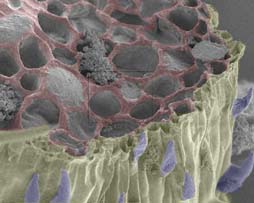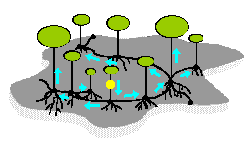Vascular bundles: the intra-net system of plants
| To the fesem simulator... |

|
Click on the gray image here left to load the virtual FESEM or
open a new window.
The FESEM simulator works with Java. If the required Java (TM) plug-in 1.3 is not installed yet on your computer, you will be automatically redirected to Sun Microsystems, Inc. Follow the (simple) step-by-step instructions to download the free plug-in. After completion of the installation procedure the virtual FESEM will be launched automatically.
|  |
Communication in plants
"Plants are dumb, mute, and passive organisms who sit and wait until they are eaten (by animals), measured (by scientists) or harvested (by farmers)!".
This general notion of plants as long dominated science, and continues to be the general impression among the wider non-scientific public. Nothing could be more wrong: plants have developed sophisticated means to exchange resources and signals among them, and they are able to "listen" and to "talk" to each other, but the way in which they share information is fundamentally different from animal and human communication. (Josef F. Stuefer).
 Fig. 1. Overview: Fracture surface through a main vein of Coleus. Zoom: xylem vessels as part of a vascular bundle
Fig. 1. Overview: Fracture surface through a main vein of Coleus. Zoom: xylem vessels as part of a vascular bundle
Download een large image of this fracture view through a vein © with painting or gray (95 KB)
Overview image: The epidermis is painted in yellow, the leaf hairs (= trichomes) are purple and the fracture surface through the wall of xylem vessels is pink.
Download een groot beeld van dit breukvlak door een bladnerf © met inkleuring of grijs (95 KB).
Communication relies on the transport of substances and signals. The transport and communication system of plants consists of two different systems of vessels: the xylem (Fig. 1), which is responsible for the transport of water, mineral nutrients and other mainly inorganic compounds, and the phloem, which is responsible for the internal transport of carbon compounds and other organic substances (signals, hormones). A number of xylem and phloem vessels are usually packed together in so-called vascular bundles (Fig. 2a and 2b ). Vascular bundles form a kind of vertical intra-net connection between the various parts of single plants: leaves (Fig.1; Fig. 2c ), flowers, stems (Fig. 2d ; circular arrangement in dicots and spread in monocots) and roots.
| Vascular bundles in leaves |
 |
 |
 |
 |
|
Fig. 2. Light microscopical views of vascular bundles of the leaf of a maize and b Yucca (both monocots), c lilac (midvein of the leaf; lilac is a dicot), and d cross-section through stems of mono- and dicots with respectively scattered and circularly arranged vascular bundles. (Click on the thumbnails for a larger view with explanations) |
Vascular bundles are essential elements for resource transport and intra-net communication in clonal plant networks
In nature there exist also a horizontal connection system involving vascular bundles: clonal plants are often 'linked' together through modified stems, called stolons when they grow above ground and rhizomes when they grow below ground. Vascular bundles in these specialized stems function as communication channels between single individuals (ramets) of a clonal network. Ramets have arisen through asexual propagation of an ancestor by means of vegetative development of stolones, rhizomes and shoots. Ramets of the same clone are thus genetically identical. Impressive clonal spreading occurs for example in bamboo, reed, silverweed and bulrush vegetation (Fig. 3a,b,c en d).
| Stolones, rhizomes and shoots |
 |
 |
 |
 |
| Fig. 3. Clones of a dwarf bamboo and b reed (Phragmites australis ) connected through rhizomes, as well as c silver weed (Potentilla anserina) connected through stolones. d Detail of rhizomes of Olney bulrush (Scirpus olneyi). |
Ecological implication of ramet-ramet communication within a clonal network
The transport of resources (e.g. water, nutrients and carbohydrates) between connected ramets in clonal communities is of great ecological importance, because it allows clonal species to support ('feed') newly produced offspring ("post-natal care"), and it enables clonal plants to internally transport limiting resources from sites of high supply (e.g. high-light spots) to sites of high demand (e.g. shaded micro-sites). Experimental studies have shown that interconnected ramets of clonal plants can mutually exchange different limiting resources (e.g. water and carbon) and thereby increase plant productivity by more than 60%. This phenomenon is called spatial division of labor. The conductivity through a ramet connection, and with it the potency to transport resources, seems to be determined by the total number of vascular bundles and the size of these vascular bundles. This possiblity is currently investigated by one of the groups of the department of plant ecology by measuring data from images of vascular bundles connecting stolones.

Furthermore, the transport of signals between spatially scattered, but interconnected ramets is likely to play a role in the reaction of plants to attacks by herbivores and pathogenes. The hypothesis is that when one ramet is damaged, it produces a signal that spreads over the whole network and switches on a defense mechanism in undamed ramets. Studies are underway to unravel the ecological implications of of what is called "systemic induced resistance"in clonal plants.
In spite of all obvious advantages, network communication and internal resource exchange has its dark side, alike modern, man-made information systems that are well-known for their vulnerability to worms and viruses. In direct analogy, efficient information transfer channels through vascular vessels bear the risk of intrusion and rapid internal spread of systemic diseases, such as fungal and viral pathogens, and toxic substances, between ramets of a clonal network.
Fly to the Department of Experimental Plant Ecology 
Software development: Jeroen van Beurden. Web structure: Remco Aalbers. Text and images: Elisabeth Pierson and Huub Geurts







